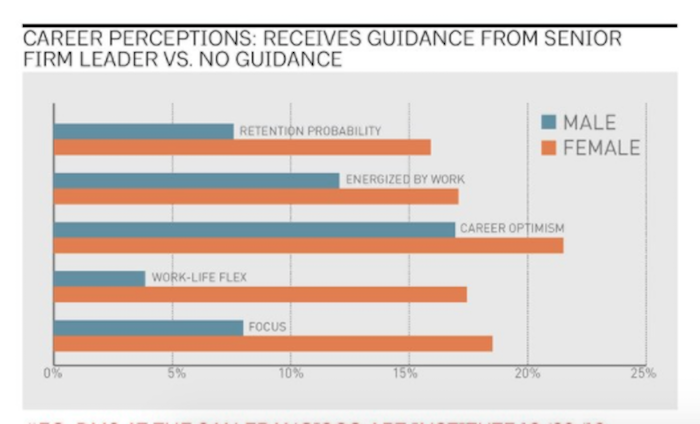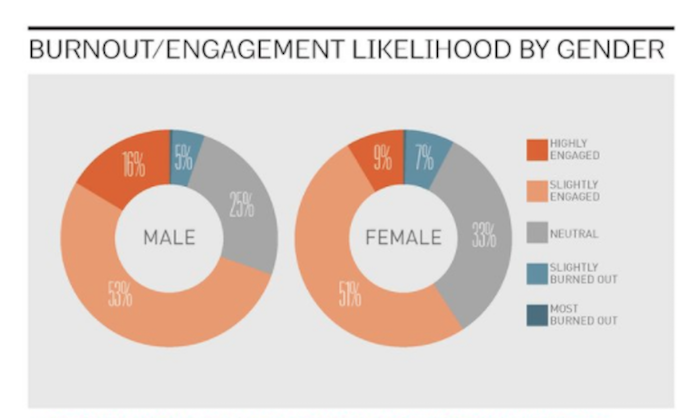A new “Equity in Architecture” survey finds that women and people of color continue to lag white men at architecture firms in career success measures such are salaries and advancement. This “achievement gap,” according to this survey, is less the result of systemic racism or sexism (although both still play in the background, like elevator music, at many firms), and more due to the lack of transparency in a firm’s process of promotions, equal access to its senior leaders, ongoing performance feedback, and having meaningful relationships at work.
The survey, conducted by the Equity by Design committee of AIA San Francisco, is based on responses to more than 80 questions from 8,664 graduates of architecture schools who are either working for an architecture firm, have worked for a firm but currently are employed in another profession, or have worked for a firm but are taking a career break or leave of absence.
The vast majority of respondents, nearly 7,000, are white males or females. And 6,600 respondents currently work at an architecture firm.
Nearly 80% of respondents said they shared their companies’ values, and 60% are engaged in decision-making and “find my work meaningful.” However, a deeper dive into the responses finds that in virtually every metric of success—including autonomy, compensation, confidence, meaningful work, focus, and work-life balance—men are more positive about their situations than women are.

The survey finds that female architects who are encouraged by a firm's senior leaders are more likely to stay with that job, and feel better about it, than men archtects. Image: Atelier Cho Thompson, courtesy of AIA San Francisco Equity in Design Committee.
One reasons might be that men are better prepared than women to take on new roles, based on their perceived respective access to a firm’s partner, principal or direct manager for professional guidance. Mentoring is critical to retention, and when women receive guidance from one of their firm’s senior leaders, they are more likely than men to stay at their jobs, be energized by their work, and be optimistic about their careers. Career guidance also has a positive effect on women architects’ attitudes about work-life balance and “focus.”
One-fifth of the survey’s respondents said that the top reason why they left their last job was low pay. And the survey finds ongoing disparities in the salaries being paid men versus women. For example, the average salary for male respondents with eight to 10 years’ experience was around $75,000, versus around $70,000 for women with the same tenure. The salary gap between men and women widens with experience. And a woman architect who is a parent, regardless of experience, is likely to be paid less than childless women, or men with or without children.
Annelise Pitts, a designer with Bohlin Cywinski Jackson and research chairman of Equity by Design, notes that women—who account for two-fifths of architecture school graduates—early in their careers often get shuttled into less-than-edifying tasks like office manager or office librarian. This “gender sorting,” says Pitts, gives women less of a shot at eventually being included in the firm’s strategic management decisions.
Once an architect has been with a firm for more than a decade, there is a significant jump in his or her perception about the likelihood of becoming a principal in their firm. However, more than half of all respondents said their firms’ leadership is “mostly male.” And 27% of male respondents and 32% of female respondents said their companies’ promotion process is either somewhat or very ineffective. Non-white males are the least likely employees to be made principals, the survey showed.
(While the survey only touches on workplace diversity, Pitts says that the biggest issue for the architectural industry remains “getting people of color into the pipeline in the first place.” Research also finds that even when minority employees are hired, they are more likely to leave firms sooner than white men or women.)
More than three-fifths of the respondents said they have “scheduling conflicts” that present challenges to maintaining a work-life balance. And women more than men attribute poor health, neglected duties, and relationship conflicts in their personal lived to this imbalance. “Women seem more willing to compromise their personal lives for work,” says Pitts. However, women are also more likely than men to turn down work-related travel because of conflicts with their personal lives.
 Women architects are more likely than men to sacrifice their personal lives for work, but are also more likely to feel the pressures of the job. Image: Atelier Cho Thompson, courtesy AIA San Francisco Equity in Design committee.
Women architects are more likely than men to sacrifice their personal lives for work, but are also more likely to feel the pressures of the job. Image: Atelier Cho Thompson, courtesy AIA San Francisco Equity in Design committee.
Burnout is more prevalent among women, especially those with less than five years experience. Half of the female respondents with five or fewer years on the job left their firm, compared to 42% of men with that same tenure who exited. Interestingly, more-tenured women appear to be less likely to leave their firms than experienced men.
Among the respondents, 667 men and 719 women currently work outside of an architecture practice. The vast majority works in another field, with a relatively small number—less than 10%—either being a full-time caregiver, a student, unemployed, or retired.
The solution to hiring and retention problems at architecture firms the survey exposes, says Pitts, comes down to them having policies in place that emphasize progressive and fair employee development, and enforcing those policies equitably and transparently. “Companies need to walk the walk,” she says.
Related Stories
MFPRO+ Research | Feb 28, 2024
New download: BD+C's 2023 Multifamily Amenities report
New research from Building Design+Construction and Multifamily Pro+ highlights the 127 top amenities that developers, property owners, architects, contractors, and builders are providing in today’s apartment, condominium, student housing, and senior living communities.
MFPRO+ Research | Feb 27, 2024
Most competitive rental markets of early 2024
The U.S. rental market in early 2024 is moderately competitive, with apartments taking an average of 41 days to find tenants, according to the latest RentCafe Market Competitivity Report.
Student Housing | Feb 21, 2024
Student housing preleasing continues to grow at record pace
Student housing preleasing continues to be robust even as rent growth has decelerated, according to the latest Yardi Matrix National Student Housing Report.
Multifamily Housing | Feb 14, 2024
Multifamily rent remains flat at $1,710 in January
The multifamily market was stable at the start of 2024, despite the pressure of a supply boom in some markets, according to the latest Yardi Matrix National Multifamily Report.
Industry Research | Feb 8, 2024
New multifamily development in 2023 exceeded expectations
Despite a problematic financing environment, 2023 multifamily construction starts held up “remarkably well” according to the latest Yardi Matrix report.
Industry Research | Jan 31, 2024
ASID identifies 11 design trends coming in 2024
The Trends Outlook Report by the American Society of Interior Designers (ASID) is the first of a three-part outlook series on interior design. This design trends report demonstrates the importance of connection and authenticity.
Apartments | Jan 26, 2024
New apartment supply: Top 5 metros delivering in 2024
Nationally, the total new apartment supply amounts to around 1.4 million units—well exceeding the apartment development historical average of 980,000 units.
Self-Storage Facilities | Jan 25, 2024
One-quarter of self-storage renters are Millennials
Interest in self-storage has increased in over 75% of the top metros according to the latest StorageCafe survey of self-storage preferences. Today, Millennials make up 25% of all self-storage renters.
Industry Research | Jan 23, 2024
Leading economists forecast 4% growth in construction spending for nonresidential buildings in 2024
Spending on nonresidential buildings will see a modest 4% increase in 2024, after increasing by more than 20% last year according to The American Institute of Architects’ latest Consensus Construction Forecast. The pace will slow to just over 1% growth in 2025, a marked difference from the strong performance in 2023.
Adaptive Reuse | Jan 23, 2024
Adaptive reuse report shows 55K impact of office-to-residential conversions
The latest RentCafe annual Adaptive Reuse report shows that there are 55,300 office-to-residential units in the pipeline as of 2024—four times as much compared to 2021.

















